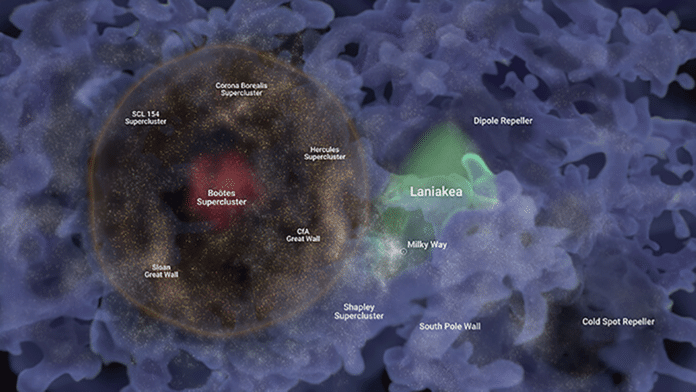Astronomer Brent Tully from the UH Institute for Astronomy and his team unexpectedly discovered an immense bubble within a web of galaxies, 820 million light-years from Earth. This bubble is believed to be a fossil-like remnant of the Universe’s birth. It has been named Hoʻoleilana, a term drawn from the Kumulipo, a Hawaiian creation chant evoking the origin of structure.
The Big Bang Theory has already predicted the existence of massive structures in the Universe. These structures result from 3D ripples found in the material of the early Universe, known as Baryon Acoustic Oscillations (BAO).
The newly discovered bubble is so huge that it spills to the edges of the sector of the sky that we were analyzing. It is a significantly stronger feature than anticipated, increasing the density of galaxies more than anticipated. Beyond what is predicted by theory, one billion light years has a tremendously big circumference. This BAO is closer than expected, suggesting a high number for the Universe’s expansion rate if its origins and history follow theory.
Astronomers located the bubble using data from Cosmicflows-4, which is, to date, the largest compilation of precise distances to galaxies. The team could see a full spherical shell of galaxies, identify its center, and show a statistical enhancement in the density of galaxies in all directions from that center.
Moreover, Hooleilana comprises several well-known objects that astronomers have previously discovered, including the Sloan Great Wall, the Hercules Cluster, and the Harvard/Smithsonian Great Wall, which contains the Coma Cluster. At its core is the Boötes Supercluster. Hooleilana features the old Boötes Void, a massive empty spherical region.
According to Tully, this could be the first time an individual structure connected to a BAO has been discovered by astronomers. The discovery could enhance scientists’ understanding of the consequences of galaxy evolution.
The team also mapped this vast bubble in 3D to understand its content and relationship with its surroundings in a better way.
Researcher Daniel Pomarede of CEA Paris-Saclay University in France said, “It was an amazing process to construct this map and see how the giant shell structure of Hoʻoleilana is composed of elements that were identified in the past as being themselves some of the largest structures of the universe.”
The team found that One of the numerous shell-like objects discovered by the Sloan Digital Sky Survey, Hoʻoleilana, had been mentioned in a 2016 study paper as the most noticeable. The prior analysis, however, did not fully reveal the extent of the structure, and the team did not conclude that a BAO had been found.
Journal Reference:
- R. Brent Tully, Cullan Howlett and Daniel Pomarède. Ho’oleilana: An Individual Baryon Acoustic Oscillation? The Astrophysical Journal. DOI: 10.3847/1538-4357/aceaf3
